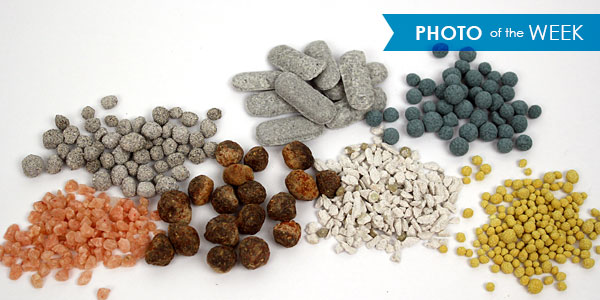This week’s photo shows agglomerate samples from FEECO’s state-of-the-art lab.
The briquettes, center gray, were processed with a briquetter. Briquetters utilize mechanical force to shape material fines into larger, denser products. They are particularly useful in creating larger agglomerates, such as charcoal and water softener briquettes.
The pink and white samples shown, however, were processed with a roll compactor. Compactors use mechanical compression to press powdery materials into sheets, which are then crushed and screened to produce the desired granules.
The remaining samples in the image were processed on a disc pelletizer. Material fines are fed onto the rotating disc and binder is continually added. As the material tumbles against itself, the binder allows the now tacky material to pick up more fines and grow in size. When the pellets reach the desired size, they exit the pan and are conveyed to a dryer to bring them down to the desired moisture level.
Briquetters, roll compactors, and disc pelletizers are three methods available when it comes to agglomerating material fines. Each of these options significantly reduces dust issues, improves product characteristics, and creates products that are easy to handle and transport.
It’s important to note that not all materials work with each piece of equipment mentioned above, and the material, end product characteristics, processing requirements and cost should be considered when selecting the best method for your specific material.
If you’re interested in agglomeration, but unsure which method is best for your material, contact us today!



